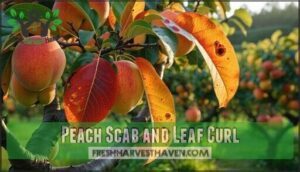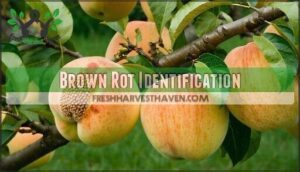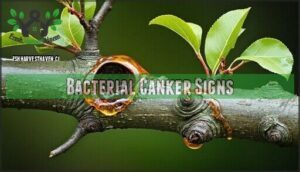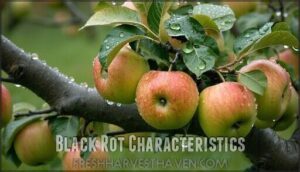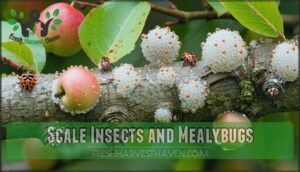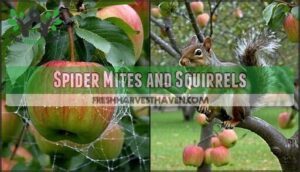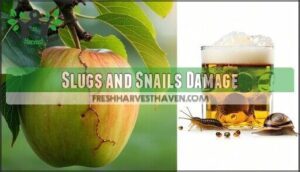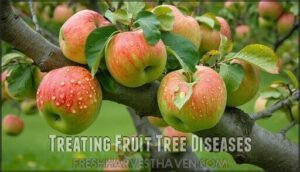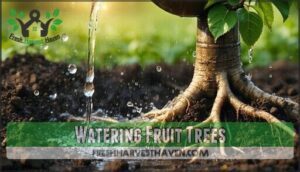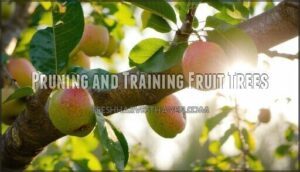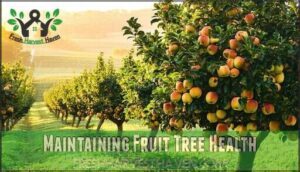This site is supported by our readers. We may earn a commission, at no cost to you, if you purchase through links.
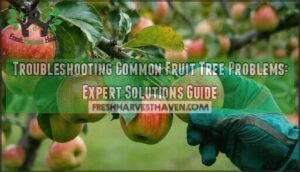
Look for discolored leaves, unusual spots, wilting, or pest activity.
Common culprits include fungal diseases like apple scab and brown rot, plus pests such as aphids and scale insects.
Check watering patterns—both overwatering and underwatering stress trees and invite problems.
Maintain proper air circulation through strategic pruning, and maintain healthy soil with appropriate fertilization.
Quick identification and prompt action prevent minor issues from becoming major headaches.
The key lies in understanding what each symptom tells you about your tree’s specific needs.
Table Of Contents
- Key Takeaways
- Identifying Fruit Tree Diseases
- Common Fruit Tree Pests
- Disease Prevention Methods
- Treating Fruit Tree Diseases
- Watering Fruit Trees
- Troubleshooting Watering Issues
- Managing Fruit Tree Nutrition
- Pruning and Training Fruit Trees
- Maintaining Fruit Tree Health
- Frequently Asked Questions (FAQs)
- Do fruit tree diseases weaken your trees?
- How do you know if a fruit tree has a disease?
- How do I know if my fruit trees are bad?
- How do you treat a fruit tree disease?
- Can you spot common fruit tree diseases early?
- What are the most serious fruit tree problems?
- How to identify fruit tree diseases?
- What does Epsom salt do for fruit trees?
- What does a sick fruit tree look like?
- How do you help a struggling fruit tree?
- Conclusion
Key Takeaways
- Watch for early warning signs – You’ll catch problems before they become serious by checking your trees weekly for discolored leaves, unusual spots, wilting, or pest activity during the growing season.
- Choose disease-resistant varieties – You can cut chemical treatments by up to 80% while boosting yields by selecting cultivars like ‘Enterprise’ apples or ‘Harrow Sweet’ pears that naturally resist common diseases.
- Master proper watering techniques – You’ll prevent both overwatering (which causes root rot) and underwatering (which stresses trees) by checking soil moisture 6-8 inches deep and adjusting based on your tree’s age and soil type.
- Use integrated management strategies – You’ll achieve the best results by combining preventive measures like strategic pruning for airflow, soil amendments, and biological controls rather than relying on single solutions.
Identifying Fruit Tree Diseases
Looking at your fruit trees with concern, wondering if those strange spots and wilting leaves signal trouble?
You’ll learn to identify the most common fruit tree diseases quickly and accurately, from the telltale olive-green blotches of apple scab to the twisted yellow leaves that mark peach leaf curl.
Apple Scab Symptoms
Apple scab announces itself through two telltale signs: olive-green leaf spots that darken to brown, and rough scabby apples with unsightly fruit lesions.
Looking at the provided paragraph about apple scab identification, here’s a short, engaging blockquote that captures the same tone:
**Spotting trouble early keeps your orchard healthy and productive.
This fungal infection targets both foliage and fruit, creating yellow spots that evolve into distinctive olive blotches. Quick identification prevents widespread damage to your orchard.
Watch for these five key apple scab symptoms:
- Olive-green leaf spots that later turn dark brown or black
- Scabby fruit lesions with rough, corky textures on apple skin
- Yellow spots appearing first on young leaves in spring
- Fruit lesions that crack and allow secondary infections to enter
- Leaf spots concentrated on upper leaf surfaces near veins
This apple scab disease thrives in wet, humid conditions. Early detection helps you implement apple scab control measures before the fungal infections spread throughout your trees.
Peach Scab and Leaf Curl
While apple scab affects your apple trees, peach scab and leaf curl present different challenges for stone fruit growers.
Scab identification starts with spotting small, dark lesions on fruit and twigs. Leaf curl symptoms appear as twisted, reddish leaves in early spring.
The disease cycle begins when spores overwinter in bark crevices, then activate during cool, wet weather around bud swell. Preventative measures include dormant copper sprays before buds open.
| Disease | Key Symptoms |
|---|---|
| Peach Scab | Dark circular spots on fruit |
| Leaf Curl | Puckered, red-tinged leaves |
| Both | Reduced photosynthesis |
| Prevention | Dormant season fungicides |
| Timing | Before bud swell |
Treatment options focus on prevention since no curative treatments exist once infection appears.
Brown Rot Identification
Brown rot strikes fast when conditions turn favorable.
You’ll spot brown lesions spreading across ripening fruit, especially after rain.
This fungal disease creates fuzzy gray-tan spore development on infected surfaces, leading to rotting fruit that eventually becomes mummified fruit hanging from branches.
Key brown rot identification features:
- Blossom withering – flowers turn brown and die during wet spring weather
- Rapid fruit lesions – brown spots expand quickly across stone fruit surfaces
- Spore development – fuzzy gray growth appears on infected areas
- Mummified fruit – dried, shriveled fruit clings to branches through winter
This fungal infection affects peaches, plums, cherries, and apricots.
Stone fruit diseases like brown rot spread through airborne spores, making early detection critical for your orchard’s health.
You can use fungicides for treatment to manage the disease.
Bacterial Canker Signs
Three telltale signs reveal bacterial canker in your stone fruit trees. Look for sunken bark areas that appear depressed or wounded on trunks and branches.
You’ll notice gum oozing – amber-colored sap seeping from infected spots. Shoot dieback occurs suddenly, with entire branches wilting unexpectedly.
The canker location determines severity – trunk infections threaten the whole tree. This bacterial disease affects cherries, plums, apples, and peaches, spreading rapidly during wet weather when wounds stay moist.
Black Rot Characteristics
Black rot strikes apples, pears, quinces, and crabapples with devastating force.
You’ll spot leaf symptoms starting as light-colored spots that darken to brown patches.
Fruit lesions appear as expanding black circles that can consume entire fruits.
The disease cycle begins in spring when spores spread from infected bark damage and mummified fruits.
Wet weather accelerates spore spread, making early detection vital for effective black rot control and diagnosing tree problems.
Common Fruit Tree Pests
You’ll encounter various pests that can damage your fruit trees throughout the growing season, from tiny aphids sucking sap to larger creatures like squirrels stealing your harvest.
Understanding these common invaders and their telltale signs helps you act quickly to protect your trees and preserve your fruit crop.
You can then take the necessary steps to address the issue and ensure a healthy harvest, by being aware of the growing season.
Aphids and Whiteflies
Through spring and summer, sapsucking insects like aphids and whiteflies target your fruit trees’ tender growth.
These tiny pests cluster on shoots and leaves, causing leaf curl and stunted growth.
Their feeding produces sticky honeydew, which attracts sooty mold that blackens foliage.
Honeydew effects create perfect conditions for fungal problems.
Fortunately, natural predators like ladybugs feast on these invaders.
For severe infestations, insecticidal soaps effectively disrupt their lifecycle without harming beneficial insects.
Scale Insects and Mealybugs
Hidden beneath branches and leaves, scale insects and mealybugs are sapsucking insects that you’ll discover through their damage before spotting them directly.
These sneaky pests hide in plain sight, slowly draining your tree’s life force.
These pests attach firmly to branches and leaves, secreting sticky honeydew that creates perfect conditions for sooty mold development.
Infestation signs include crusty bumps resembling barnacles (scale) or white cottony clusters (mealybugs).
Natural predators like ladybugs provide biological control, but severe infestations require targeted control methods.
Horticultural oils effectively smother these pests, while proper tree spacing improves air circulation.
The honeydew effects extend beyond stickiness—this substance attracts ants and promotes sooty mold growth, creating multiple problems that compound over time.
Spider Mites and Squirrels
Spider mites and squirrels can turn your orchard into a battlefield. Spotting webbing damage is key for Mite Identification, while Bark Stripping signals squirrel mischief.
For practical pest control and Squirrel Deterrents, try these steps:
- Spray leaves with water to knock off sapsucking insects and reduce webbing damage.
- Install metal tree guards to block bark stripping.
- Use sturdy netting to minimize fruit loss from these persistent fruit tree pests, which can cause significant webbing damage.
Slugs and Snails Damage
Slugs and snails creep up from below, leaving distinctive silvery trails and irregular fruit bites on low-hanging fruit.
You’ll recognize their smooth-edged, ragged holes easily.
Combat these fruit tree pests with copper tape barriers around tree bases, snail traps filled with beer, or nematode control applications.
Natural predators like birds help, but manual removal during evening hours provides immediate pest control results when these nocturnal nibblers emerge.
Disease Prevention Methods
You can prevent most fruit tree diseases by choosing the right varieties and creating healthy growing conditions.
Smart selection and proper care techniques work better than trying to cure problems after they start, which is why proper care is essential.
Selecting Disease-Resistant Varieties
Choosing disease-resistant varieties dramatically reduces your orchard’s susceptibility to persistent fruit tree diseases.
Disease resistance acts as your first line of defense, often cutting chemical treatments by up to 80% while boosting yields substantially. These genetic adaptations aren’t bulletproof, but they’re your strongest weapon against common threats.
Smart variety selection considers both rootstock resistance and regional adaptations. Heirloom varieties sometimes lack modern disease prevention traits, making newer cultivars worth considering. Genetic diversity helps protect against evolving pathogens.
Consider these proven performers:
- ‘Enterprise’ apple – resists scab, fire blight, cedar apple rust, and powdery mildew
- ‘Harrow Sweet’ pear – excellent fire blight resistance with superior fruit quality
- ‘Contender’ peach – withstands bacterial spot and late frost damage effectively
Tree disease resistance varies by region, so consult local extension services for area-specific recommendations.
Proper Pruning Techniques
With disease-resistant varieties in your orchard, pruning techniques become your next line of defense against fruit tree problems.
Sterilizing tools between cuts prevents pathogen spread—use rubbing alcohol or bleach solution. Pruning timing matters: dormant season cuts heal faster and reduce infection risk.
Make clean cuts at proper branch angles—45 degrees for most situations. Focus on branch spacing to improve airflow and light penetration.
Remove diseased wood first, then shape your tree’s framework. Wound sealing isn’t necessary for healthy trees, as natural healing works best.
Strategic fruit tree pruning creates structure while preventing disease establishment. To maximize fruit production, consider evaluating tree size.
Soil Management Strategies
Your soil’s foundation determines whether your fruit trees thrive or struggle against disease.
Three key strategies create ideal soil conditions for healthy, disease-resistant trees.
Start with soil testing methods to assess your current soil pH and nutrient levels.
Most fruit trees prefer a soil pH balance between 6.0 and 7.0 for perfect nutrient uptake.
Transform your soil with these proven approaches:
- Add organic amendments like compost and aged manure to boost beneficial microorganisms and improve soil structure
- Install drainage improvement systems in clay soils to prevent waterlogged conditions that cause root rot
- Maintain proper soil pH through lime applications for acidic soils or sulfur for alkaline conditions.
Regular soil management through these soil amendments creates healthy soil that naturally resists disease-causing pathogens while supporting strong root development.
Improving Air Circulation
Good air circulation keeps your fruit trees healthy by reducing humidity around leaves and branches.
When moisture lingers, fungal diseases thrive. Proper ventilation through strategic pruning techniques helps foliage dry faster after rain or morning dew.
powdery mildew
humid areas
moisture-loving fungi
splash-up infections
outbreaks
Focus on canopy management by removing crossing branches and maintaining proper branch angles. Tree spacing matters too—overcrowded orchards trap stagnant air.
These airflow benefits substantially reduce your disease problems naturally.
Treating Fruit Tree Diseases
When disease strikes your fruit trees, quick action prevents costly damage and saves your harvest.
You’ll need the right combination of biological controls, chemical treatments, and organic alternatives to restore tree health effectively.
Biological Control Methods
Nature’s pest control army can transform your orchard management approach.
Beneficial insects like ladybugs consume up to 5,000 aphids during their lifetime, while predatory mites reduce spider mite populations by over 80%.
Parasitic wasps target codling moths through lifecycle disruption, and nematode control effectively manages soil-dwelling pests.
Here’s your biological control arsenal:
- Release ladybugs for aphid management and scale insect suppression
- Apply microbial pesticides like Bacillus thuringiensis for caterpillar control
- Introduce parasitic wasps to disrupt moth reproduction cycles
- Deploy beneficial nematodes for underground pest larvae elimination
These natural predators work within integrated pest management systems, reducing chemical dependency while maintaining effective pest suppression throughout your growing season.
Chemical Control Options
When chemical treatments become necessary, effective fungicide application requires strategic timing and proper dosage calculation to protect your fruit trees.
Chemical control options deliver targeted protection against persistent diseases:
- Apply captan or chlorothalonil during spray schedules at petal fall for brown rot and scab prevention
- Use propiconazole fungicides 2-3 weeks before harvest for late-season disease control
- Rotate bactericides and insecticides between chemical classes to prevent pesticide resistance
Consider using copper-based solutions for broad-spectrum disease control. Follow chemical safety protocols including proper protective equipment and pre-harvest intervals to guarantee both tree health and food safety.
Organic Treatment Alternatives
When facing fruit tree problems, organic treatment alternatives offer gentle yet effective solutions that protect both your trees and beneficial insects.
Neem Oil serves as your first line of defense – mix 2 tablespoons with water and soap to disrupt pest lifecycles while safeguarding helpful pollinators. Consider neem oil application for thorough pest control.
Companion planting with marigolds and mint creates natural barriers against unwanted visitors.
| Treatment | Application | Target |
|---|---|---|
| Neem Oil Spray | 2 tbsp per gallon water | Aphids, scale insects |
| Garlic Spray | Crushed cloves steeped 24hrs | Fungal diseases |
| Beneficial Insects | Release ladybugs/lacewings | Pest control |
| Compost Tea | Weekly soil drench | Soil Health improvement |
| Marigold Borders | Plant around tree base | Natural pest deterrent |
Homemade sprays using garlic or baking soda tackle fungal issues effectively.
Boost your tree’s natural defenses by enriching soil health with organic compost and mulches – healthy trees resist problems naturally.
Integrated Pest Management
Integrated pest management (IPM) transforms how you’ll tackle fruit tree problems by combining smart monitoring with strategic action.
You’ll use weekly inspections and sticky traps to spot issues early, then deploy biological controls like ladybugs before considering reduced pesticides.
This layered approach cuts chemical use by 50-75% while maintaining effective pest control, creating economic thresholds that protect both your trees and wallet.
Watering Fruit Trees
Proper watering forms the foundation of healthy fruit trees, yet many gardeners struggle with finding the right balance between too much and too little moisture.
Understanding your tree’s specific water needs based on its age, soil conditions, and environmental factors will help you avoid common watering mistakes.
These mistakes can lead to root rot, stunted growth, or poor fruit production, highlighting the importance of precise watering techniques for optimal tree health.
Tree Age and Size Considerations
Young trees need your attention more than mature ones—water them twice weekly during their first two years while they establish roots.
Dwarf varieties require less water than standard trees despite rootstock influence on uptake rates.
As trees age, mature trees develop deeper root systems that access soil moisture more efficiently.
However, don’t neglect older trees completely—they’ll show tree weakening signs if consistently under-watered, affecting both health and fruit production.
Soil Type and Quality Impact
Understanding soil fundamentals transforms your watering strategy completely.
Different soil types dramatically affect water retention and nutrient availability.
Soil pH determines how well trees absorb essential minerals.
Address drainage issues and soil compaction through these steps:
- Test soil pH levels annually using digital meters
- Combat poor drainage with organic amendments and raised beds
- Break up soil compaction using broadfork tools carefully
- Boost root health by adding compost and organic matter regularly
Smart soil amendments create the foundation for thriving fruit trees.
Environmental Conditions and Evaporation
Weather’s daily assault on your fruit trees demands strategic defense. Temperature effects and sunlight exposure drive evaporation rates that can double water loss on scorching days. Wind impact accelerates moisture theft, while humidity levels provide natural protection.
Monitor these conditions to master your watering schedule:
| Environmental Factor | Impact on Water Needs |
|---|---|
| High temperatures + wind | Double watering frequency |
| High humidity + shade | Reduce watering by 30% |
| Full sun + dry air | Check soil moisture daily |
Create beneficial microclimates with windbreaks and proper spacing. Your trees will thank you when roots stay consistently hydrated despite nature’s challenges.
Species-Specific Water Requirements
Different fruit trees have distinct watering needs that affect their health and productivity.
While environmental conditions influence water loss, each species requires specific hydration approaches to maximize fruit quality and prevent stress.
Apple Water Needs: Full-size apple trees typically use 5-10 gallons per week in dry conditions, with dwarf varieties requiring more frequent watering due to smaller root systems.
Inadequate water during early fruit development commonly leads to bitter pit, especially in Honeycrisp apples.
Citrus Irrigation: Mature citrus trees require 1-1.5 inches of water weekly during growing season, applied deeply to encourage strong root development.
Overwatering contributes to root rot, particularly Phytophthora infection in saturated soils.
Stonefruit Moisture: Stone fruits need 2-4 inches weekly during fruit development, with Peach Hydration being critical 2-3 weeks before harvest.
Cherries are particularly sensitive to overwatering, which increases fruit cracking risk.
Fig Watering: Figs tolerate some drought but yield improves substantially with 1-1.5 inches weekly during summer.
Here are key species-specific requirements:
- Monitor soil moisture in top 6-12 inches depending on tree type
- Adjust frequency based on rootstock – dwarf varieties dry out faster
- Increase watering during bloom and fruiting periods by up to 50%
- Prevent both underwatering and overwatering by checking soil before irrigation
Troubleshooting Watering Issues
Water problems can make or break your fruit harvest, but identifying the root cause doesn’t have to be complicated.
You’ll learn to spot the telltale signs of too much or too little water and adjust your watering schedule to keep your trees thriving year-round.
Signs of Overwatering and Underwatering
Trees reveal their hydration status through visible symptoms you can easily recognize.
Overwatering creates yellow, wilted leaves with mushy, brown roots that smell foul. Underhydration produces crispy leaf edges, brittle roots, and poor fruit quality.
Check soil moisture by digging 6-8 inches deep—soil moisture sensors provide precise readings for ideal root health and growth rate.
| Symptom | Overwatering | Underwatering |
|---|---|---|
| Leaf Color | Yellow, drooping | Brown edges, curled |
| Root Health | Mushy, dark, rotting | Dry, brittle, shrunken |
| Growth Rate | Stunted, weak shoots | Slow, sparse development |
| Fruit Quality | Poor taste, soft texture | Small, bitter, dropping |
| Soil Moisture | Constantly soggy | Pulls away from trunk |
Recognizing Stress and Adjusting Practices
Your fruit trees broadcast stress signals through subtle changes that require immediate attention. When you spot these warning signs, adjust your watering practices to restore tree health and prevent long-term damage.
Stress Indicators include:
- Wilted leaves that remain drooped despite adequate soil moisture
- Premature fruit drop occurring before natural harvest time
- Bark developing vertical cracks or unusual discoloration patterns
- Branch tips showing brown, scorched edges or yellowing foliage
Environmental Impact factors like temperature swings, drought, or excessive rainfall trigger these symptoms. Preventative Measures involve monitoring your trees weekly and implementing Adaptive Strategies such as mulching, adjusting irrigation schedules, or providing temporary shade during heat waves to support Long-Term Health.
Monitoring Soil Moisture for Optimal Hydration
Understanding your tree’s stress signals helps you catch problems before they become serious.
Check soil dampness by digging 6-8 inches down – it should feel like a wrung-out sponge.
Soil moisture sensors provide precise readings to enhance irrigation scheduling and prevent both overwatering and underwatering issues.
| Moisture Level | Action Needed |
|---|---|
| Too dry (crumbly) | Increase watering frequency |
| Perfect (spongy) | Maintain current schedule |
| Too wet (muddy) | Reduce watering, improve drainage |
| Standing water | Check for root rot signs |
Watch for drought stress signs like wilting leaves and adjust your watering practices accordingly for ideal root zone hydration.
Managing Fruit Tree Nutrition
Your fruit trees need proper nutrition to produce healthy harvests and resist diseases. You can achieve this through strategic fertilization, effective mulching, quality soil amendments, and balanced nutrient management.
Fertilization Strategies
Proper fertilization strategies transform struggling fruit trees into productive powerhouses. Start with soil testing every 2-3 years to identify nutrient deficiencies before applying fertilizers blindly.
Choose balanced NPK fertilizers or organic alternatives like compost for gradual nutrient release. Time applications during early spring for maximum growth benefits, stopping by July to prevent winter damage.
To find the right fertilizer products, consider online resources.
- Test soil annually for saplings, every 2-3 years for mature trees
- Apply balanced fertilizers in early spring during bud break
- Choose slow-release options to reduce nutrient leaching by 30-40%
- Stop fertilizing by July to allow proper dormancy preparation
Mulching for Nutrient Retention
Nutrient-rich mulch transforms your fruit trees into thriving powerhouses through strategic soil care.
Choose mulch types like compost for fast decomposition rates or bark chips for longevity.
These materials feed soil microbes, enhancing nutrient cycling and water retention.
Apply 2-4 inches around trees, avoiding trunks to prevent rot.
This mulching practice complements fertilization by improving nutrient availability through continuous organic matter breakdown.
Composting and Soil Amendments
Compost benefits transform your soil into a thriving ecosystem where fruit trees flourish.
Adding organic matter through composting creates ideal soil health while improving water retention and nutrient cycling.
Here’s how to enhance your soil care:
- Create rich compost from kitchen scraps and fallen leaves
- Test soil pH and add lime or sulfur as needed
- Mix in amendment types like aged manure or worm castings
Balancing Nutrient Levels
Yellowing leaves signal your fruit trees need help. Soil testing reveals exactly what’s missing, while deficiency symptoms guide your next move.
| Nutrient | Deficiency Symptoms |
|---|---|
| Nitrogen | Yellow older leaves, stunted growth |
| Phosphorus | Purple leaf tints, poor root development |
| Potassium | Brown leaf edges, weak branches |
| Iron | Yellow leaves with green veins |
| Magnesium | Yellow between leaf veins |
Fertilizer types address specific needs—synthetic for quick fixes, organic fertilizers for long-term health.
Nutrient timing matters too; spring feeding supports growth, while fall applications prepare trees for winter. Organic amendments like compost improve soil structure and balancing nutrient levels naturally.
Pruning and Training Fruit Trees
Proper pruning and training techniques form the foundation of healthy fruit trees that resist disease and produce quality harvests.
You’ll learn how strategic cuts improve air circulation, reduce fungal infections, and guide young trees toward ideal structure for years of productive growth, using proper pruning techniques.
Pruning Techniques for Disease Control
Sharp pruning cuts prevent disease spread when you sterilize tools between cuts.
Dormant pruning during winter reduces stress while canker removal eliminates infection sources.
Strategic airflow pruning creates space for ventilation, reducing fungal infections.
Wound sealing protects larger cuts from pathogens.
Many gardeners find success using specialized pruning equipment.
Key disease control strategies include:
- Remove diseased branches 6 inches below visible symptoms
- Clean tools with rubbing alcohol between each cut
- Focus cuts on improving airflow through dense canopy areas
Training Young Trees for Structure
Building strong structure in young fruit trees requires selecting the right training system for your variety.
Central Leader works best for apples and pears, creating a dominant trunk with horizontal scaffold selection. Open Center suits stone fruits like peaches, forming a vase shape for better airflow.
Modified Leader combines both approaches. Focus on creating proper branch angles of 45-60 degrees during pruning timing in late winter.
These pruning techniques for training young trees establish the foundation for healthy fruit production and easier maintenance throughout the tree’s life.
Thinning Fruit for Better Quality
Strategic fruit thinning transforms your harvest from quantity to quality.
Remove excess or damaged fruit when they’re marble-sized, spacing remaining fruit 4-6 inches apart.
This prevents breakage from heavy loads while boosting fruit size and tree health.
Proper thinning timing guarantees optimal yield and prevents biennial bearing cycles.
Your fruit tree troubleshooting efforts pay off with premium fruit quality and consistent fruit production year after year.
Pruning for Air Circulation and Sunlight
Proper pruning transforms your fruit tree into a disease-fighting powerhouse. Pruning timing in late winter maximizes healing before growing season.
Focus on branch spacing and canopy density to create ideal airflow improvement. Remove crossing branches and water sprouts to enhance sunlight penetration.
These proper pruning techniques boost airflow and sunlight exposure, preventing fungal problems while improving fruit quality and tree health. Sanitizing tools helps prevent disease transmission effectively.
Maintaining Fruit Tree Health
You’ve worked hard to establish healthy fruit trees, but maintaining their long-term health requires ongoing attention and strategic planning.
Success comes from combining regular monitoring with proactive management techniques that prevent problems before they become serious threats.
Regular Monitoring for Pests and Diseases
Vigilance serves as your first line of defense against fruit tree troubles.
You’ll want to inspect your trees weekly during growing season, checking for early detection of problems like aphid clusters or unusual leaf spots.
Pest identification becomes easier when you know what to look for—webbing suggests spider mites, while sticky honeydew indicates scale insects.
Disease symptoms often appear as discolored leaves, cankers, or fruit lesions.
Adjust your monitoring frequency based on seasonal risks and weather conditions.
Establish action thresholds to determine when preventive measures shift to curative measures, ensuring timely intervention before issues escalate.
Record Keeping for Tree Health
Three essential components transform record keeping into your orchard’s health management system.
Document spray schedules and treatment logs to track what works.
Monitor pest sightings and disease symptoms alongside yield data to spot patterns.
Include weather impacts and growth tracking details—this creates a diagnostic roadmap for future decisions and helps you catch problems early.
Planning for Future Fruit Production
Planning your orchard’s future success requires strategic thinking about long-term productivity.
Smart decisions today prevent tomorrow’s headaches and maximize your harvest potential.
- Variety Selection: Choose disease-resistant cultivars suited to your climate considerations and pollination needs
- Orchard Layout: Design spacing that promotes airflow while ensuring adequate cross-pollination between compatible varieties
- Rootstock Selection: Match rootstock to soil conditions and desired tree size for ideal fruit production longevity
Integrating Multiple Management Strategies
After planning your orchard’s future, you’ll need to weave together different management approaches.
Combining IPM with varietal selection creates a robust defense against fruit tree problems.
Your holistic orchard care strategy should blend preventative measures like proper pruning techniques with soil management and disease prevention.
This integrated approach tackles pest management from multiple angles, ensuring long-term planning success.
Preventive Measures Curative Measures
Frequently Asked Questions (FAQs)
Do fruit tree diseases weaken your trees?
Yes, fruit tree diseases definitely weaken your trees. They drain energy, reduce fruit production, compromise immune systems, and make trees vulnerable to other problems like pests and environmental stress.
How do you know if a fruit tree has a disease?
An ounce of prevention is worth a pound of cure. Look for yellow or brown spots on leaves, wilting branches, unusual growths, or fruit with dark lesions and fuzzy mold.
How do I know if my fruit trees are bad?
Check for yellowing leaves, dark spots, cankers with oozing sap, premature fruit drop, wilting branches, or stunted growth.
Look for unusual discoloration, pest damage, or fungal growth on bark and fruit.
How do you treat a fruit tree disease?
Disease in your fruit trees acts like a storm cloud brewing—early identification and swift action can save your harvest.
Remove infected parts immediately, sterilize pruning tools between cuts, and apply appropriate fungicides like captan or copper-based treatments to prevent spread.
Can you spot common fruit tree diseases early?
Early detection starts with weekly inspections of leaves, fruit, and bark. Look for discolored spots, wilting, unusual growths, or pest damage. Catching problems early makes treatment easier and more effective.
What are the most serious fruit tree problems?
While you might think all fruit tree issues are manageable, fire blight, brown rot, and bacterial canker can kill trees quickly.
These diseases spread rapidly, destroy entire crops, and require immediate action to prevent total loss, often caused by bacterial canker.
How to identify fruit tree diseases?
Look for discolored spots on leaves, fruit, and bark.
Yellow, brown, or black patches often signal fungal infections.
Check for wilting, unusual growths, oozing sap, or white powdery coatings that indicate specific diseases.
What does Epsom salt do for fruit trees?
Epsom salt provides magnesium sulfate to fruit trees, helping chlorophyll production and nutrient absorption. You’ll notice greener leaves and improved fruit quality when applied properly to magnesium-deficient soil.
What does a sick fruit tree look like?
When your fruit tree’s health takes a turn for the worse, you’ll spot yellowing leaves, wilting branches, unusual spots, cankers oozing sap, stunted growth, and premature fruit drop.
How do you help a struggling fruit tree?
Start by identifying the specific problem through careful observation of symptoms like leaf discoloration, fruit damage, or pest presence.
Then apply targeted treatments: prune affected areas, improve drainage, adjust watering, and use appropriate fungicides or pest controls to address the issue, focusing on complete concepts for effective resolution.
Conclusion
Successfully troubleshooting common fruit tree problems requires vigilance, knowledge, and timely action.
By identifying diseases early, managing pests effectively, and maintaining proper watering practices, you’ll keep your trees healthy and productive.
Remember that prevention beats treatment, so focus on selecting resistant varieties, pruning correctly, and monitoring regularly.
These strategies work together to create thriving fruit trees that reward your efforts with abundant harvests year after year, through proper watering practices.
- https://www.flickr.com/photos/lmilliron/4593448688
- https://commons.wikimedia.org/wiki/File:Bacterial_Canker_on_Cherry.JPG
- https://www.publicdomainpictures.net/en/view-image.php?image=94740&picture=apple-disease
- https://pestcheck.ca/service-areas/richmond-pest-control/
- https://www.reddit.com/r/BackyardOrchard/comments/1bfn8wb/well_guys_the_peach_leaf_curl_got_me_as_well/


